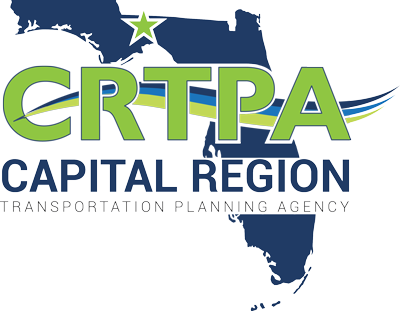THE LATEST: The solicitation of new Transportation Alternatives (TA) applications is currently underway as a result of the FDOT District 3 opening up the cycle in November 2025. TA applications must be submitted through the GAP system and are due by 11 PM on Friday, January 16, 2026 (see below “NOTE”).
As the region’s Transportation Planning Agency, the CRTPA is required to manage the solicitation, ranking and submittal of eligible TAP projects prior to provision to FDOT District 3 for annual funding consideration. Applications are solicited by the CRTPA every two years. The initial review and draft ranking of applications is performed by the CRTPA’s TA Subcommittee (consisting of members from the CRTPA’s two committees) prior to consideration and adoption of ranked projects on the CRTPA’s annual Transportation Alternatives Project Priority List by the CRTPA Board.
Transportation Alternatives programs and projects encompass a variety of smaller-scale transportation projects such as pedestrian and bicycle facilities, recreational trails, safe routes to school projects, community improvements such as historic preservation and vegetation management, and environmental mitigation related to stormwater and habitat connectivity. Funding for the TAP was most recently authorized in the 2021 Infrastructure Investment and Jobs Act (also known as the “Bipartisan Infrastructure Law” (BIL)) which provides a set-aside of Surface Transportation Block Grant (STBG) program funding for transportation alternatives. The following types of activities are eligible for TA funding:
-
- Pedestrian and/or Bicycle facilities (Construction, planning, and design of off-road trail facilities or on-road facilities for pedestrians, bicyclists, and other nonmotorized forms of transportation); Safe Routes for Non-Drivers (Construction, planning, and design of infrastructure related projects and systems that provide safe routes for non-drivers, including children, older adults, and individuals with disabilities to access daily needs); Conversion of Abandoned Railway Corridors to Trails (Conversion and use of abandoned railroad corridors into trails for pedestrians, bicyclists, or other nonmotorized transportation users); Scenic Turnouts and Overlooks (Construction of turnouts, overlooks, and viewing areas); Outdoor Advertising Management (Inventory, control, or removal of outdoor advertising); Historic Preservation and Rehabilitation of Historic Transportation Facilities (Projects providing historic preservation or rehabilitation of historic transportation facilities); Vegetation Management (Vegetation management in public transportation ROW to improve roadway safety, prevent invasive species, and erosion control); Archaeological Activities (Archaeological activities related to impacts from transportation projects funded by FHWA); Stormwater Mitigation (Environmental mitigation activities addressing stormwater management, control, and water pollution prevention or abatement related to transportation projects); Wildlife Management (Wildlife mitigation and reduction of wildlife mortality, or to restore and maintain connectivity among terrestrial or aquatic habitats); Boulevards (Boulevards, defined as a walkable, low speed (35 mph or less) divided arterial thoroughfares in urban environments designed to carry both through and local traffic, pedestrians, and bicyclists. These may be high ridership transit corridors; serve as primary goods movement and emergency response routes; and use vehicular and pedestrian access management techniques that promote economic revitalization and follow complete street principles); Recreational Trails Program (Recreational trails compliant with 62-S-2, Florida Administrative Code, and 23 U.S.C. 104 (b)); Safe Routes to Schools (SRTS) (SRTS projects, codified as 23 U.S.C. 208, that substantially improves the ability of kindergarten through 12th grade students (vulnerable road users) to walk and / or bicycle to school]. Traditionally includes sidewalks, traffic calming and speed reduction, traffic diversion improvements, pedestrian and bicycle crossings, on-street bicycle facilities, off-street bicycle facilities, and bicycle parking facilities at public schools).
NOTE: Applications and forms may be found on the Florida Grant Application Program (GAP) at www.flgap.com (access to the site may be obtained by clicking the link at the bottom of the webpage that states, “Request User Access”). The CRTPA’s TA Evaluation Criteria that will be used in the evaluation of TA applications may be viewed by clicking here. Additional information may be found at the following FDOT link.
2025/ 2026 CRTPA TA Program Timeline
- November 1, 2025 – FDOT District 3 TA Solicitation Cycle Opens (FY 2028 – FY 2032)
- January 16, 2026 – TA Applications Due (Must be submitted through the Florida GAP)
- February 26, 2026 – CRTPA TA Subcommittee applicant interviews and project ranking recommendation (Tallahassee Room (2nd Floor), Tallahassee City Hall)
- April 7, 2026 – CRTPA Committees (TAC & CMAC) scheduled to discuss the Draft FY 2027 – FY 2030 TA Project Priority List
- April 21, 2026 (1:30 pm) – CRTPA adopts the FY 2028 – FY 2032 TA Project Priority List
What type of projects are eligible for transportation alternatives program funding?
See information at top of page regarding eligible projects.
Who can apply?
The following are eligible entities to receive TAP funds pursuant to 23 USC 133(h)(4)(B):
- local governments;
- regional transportation authorities;
- transit agencies;
- natural resource or public land agencies;
- school districts, local education agencies, or schools;
- tribal governments; and
- any other local or regional governmental entity with responsibility for oversight of transportation or recreational trails (other than a metropolitan planning organization or a State agency) that the State determines to be eligible, consistent with the goals of subsection (c) of section 213 of title 23.
Under the TAP, nonprofits are not eligible as direct grant recipients of the funds. Nonprofits are eligible to partner with any eligible entity on an eligible TAP project.
Important
Submitted applications are required to include proof of right-of-way ownership from the submitting agency. Only applications that identify that the proposed project is located within public ownership will be considered. Such proof includes the provision of plats, deeds, prescriptions and certified surveys.
Funding requests should be no greater than approximately twice ($1.32M) the CRTPA’s annual TA allocation (approximate annual allocation is $660,000).
Questions?
For more information, contact Greg Burke at the CRTPA (891-8626)
